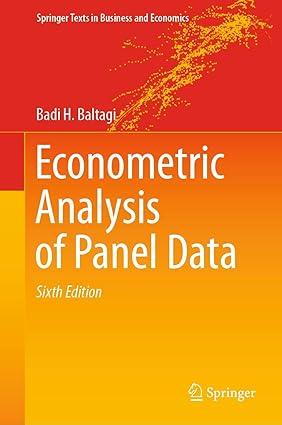Random effects and spatial autocorrelation with equal weights. This is based on Baltagi (2006). Consider the panel
Question:
Random effects and spatial autocorrelation with equal weights. This is based on Baltagi (2006). Consider the panel data regression model described in (13.1) with random individual effects and spatially autocorrelated remainder disturbances described by (13.2) and (13.3). In this special case, \(W\) is an \(N \times N\) weighting matrix with zero elements across the diagonal, and equal elements \((1 /(N-1))\) off the diagonal. In other words, the disturbance for each unit is related to an average of the \((N-1)\) disturbances of the remaining units. Such a weighting matrix would naturally arise if all units are neighbors to each other and there is no other reasonable or observable measure of distance between them. \(W\) can be written as \(W=\frac{J_{N}}{(N-1)}-\frac{I_{N}}{(N-1)}\).
(a) Show that GLS on this model can be obtained using an OLS regression of \(y_{t i}^{*}=\left(y_{t i}-\theta_{1} \bar{y}_{t .}-\theta_{2} \bar{y}_{. i}+\theta_{3} \bar{y}_{. .}\right)\)on \(X^{*}\) similarly defined. Here, \(\bar{y}_{t}\). denotes the sample average over individuals; \(\bar{y}_{. i}\) denotes the sample average over time; and \(\bar{y}_{\text {.. }}\) denotes the average over the entire sample. The \(\theta^{\prime} s\) are scalars which depend on \(N, \lambda\), and the variance components \(\sigma_{\mu}^{2}\) and \(\sigma_{u}^{2}\).
(b) Show that if there is no spatial autocorrelation, i.e., \(\lambda=0\), then \(y_{t i}^{*}\) reduces to \(\left(y_{t i}-\theta_{2} \bar{y}_{. i}\right)\). This is the familiar Fuller and Battese (1973) random effects transformation. Show that if there are no random effects, i.e., \(\sigma_{\mu}^{2}=0\), and \(N \rightarrow \infty\), then \(y_{t i}^{*}=\left(y_{t i}-\right.\) \(\lambda \bar{y}_{t .}\).
(c) Show that in the cross-section spatial regression model with \((T=1)\) and equal weight matrix, OLS is equivalent to GLS as long as there is a constant in the regression.
(d) For the spatial panel regression with equal weights, show that two special cases where OLS is equivalent to GLS, are the following: (i) the trivial case where \(\sigma_{\mu}^{2}=0\) and \(\lambda=0\); and (ii) when the matrix of regressors \(X\) is invariant across time. Baltagi (2006) showed that these results for the equal weight matrix hold whether we use the spatial autoregressive (SAR) specification for the disturbances, or the spatial moving average (SMA) specification described in Anselin (1988), or the spatial error components (SEC) specification described in Kelejian and Robinson (1995), or the Kapoor, Kelejian and Prucha (2007) panel data regression model with spatially correlated error components.
\[\begin{equation*}
y_{t i}=X_{t i}^{\prime} \beta+u_{t i}, i=1, . ., N ; t=1, \cdots, T \text {, } \tag{13.1}
\end{equation*}\]
\[\begin{equation*}
u_{t}=\mu+\epsilon_{t} \tag{13.2}
\end{equation*}\]
\[\begin{equation*}
\epsilon_{t}=\lambda W_{N} \epsilon_{t}+u_{t} \tag{13.3}
\end{equation*}\]
Step by Step Answer:







